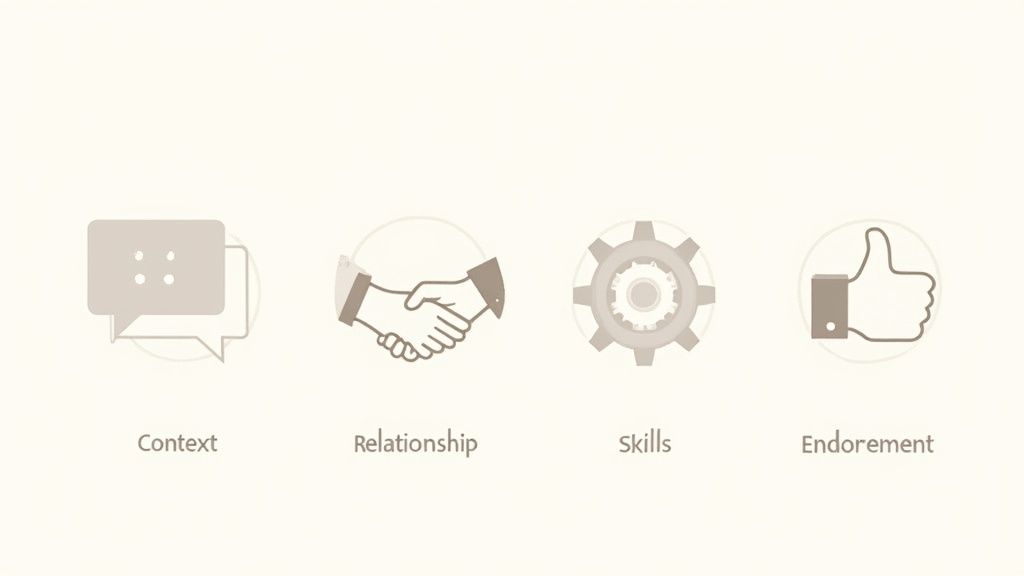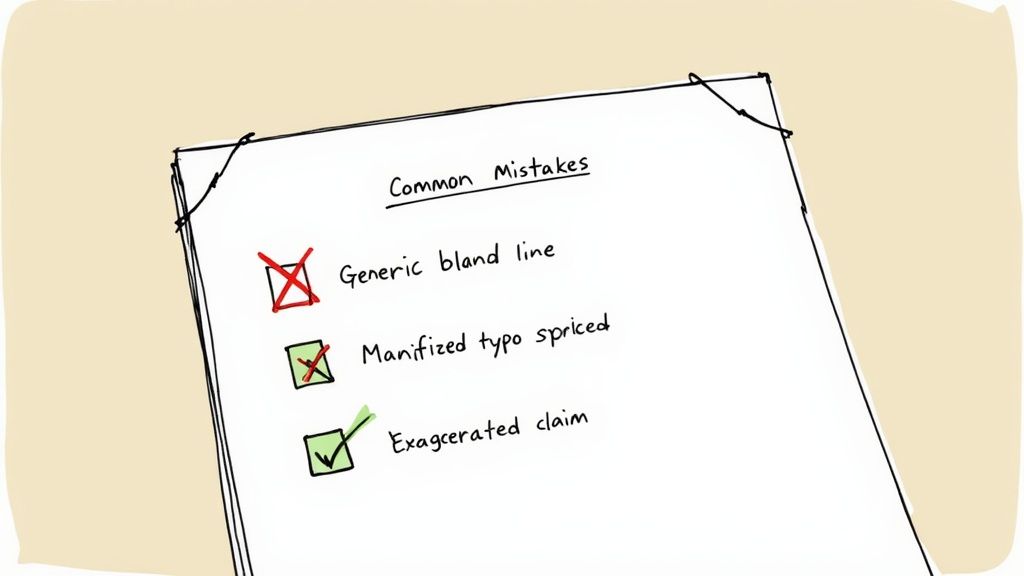Write a LinkedIn Recommendation That Actually Matters
Learn how to write a LinkedIn recommendation that stands out. Get practical tips and real-world examples to boost your network's credibility and yours.

Writing a LinkedIn recommendation doesn't have to be complicated. It boils down to a simple, ethical formula: a strong opening line, a quick note on your professional relationship, a highlight of 1-2 specific skills backed by a real, honest example, and a clear, confident endorsement at the end.
That’s it. Following this structure ensures your recommendation is credible, specific, and genuinely helpful to the person you're writing it for—and the recruiters who will be reading it.
Why Your LinkedIn Recommendation Is a Career Asset
Before we get into the nuts and bolts of how to write one, it's worth taking a moment to understand why this actually matters. A thoughtful, honest recommendation is more than just a nice gesture; it's a powerful career asset for everyone involved. It builds your professional credibility just as much as it boosts the recipient's.
Spending a few minutes to write something meaningful can strengthen your professional relationships and position you as a supportive, insightful leader in your network. It’s an affordable investment of your time that reinforces a culture of mutual, ethical support. If you're looking for more ways to build your professional presence, you can find more tips on our blog at https://contentide.com/blog.
The Real Impact on Hiring
Let’s be clear: authentic endorsements genuinely influence hiring decisions. The data doesn’t lie. LinkedIn recommendations are a serious tool, with 79% of recruiters considering them a significant factor when they're looking at candidates.
Even more telling? 70% of hiring managers say they trust these recommendations more than they trust traditional references. Honing your ability to improve business communication makes your words here even more powerful.
This infographic really drives home how much these recommendations can affect hiring outcomes.
It’s clear that a well-written recommendation is far more than just profile decoration. Let's look at the direct benefits.
The Impact of a Single Recommendation
| Benefit | Key Statistic |
|---|---|
| Increased Profile Credibility | 70% of hiring managers trust them more than traditional references. |
| Higher Candidate Consideration | 79% of recruiters see them as a significant evaluation factor. |
| Improved Job Offer Acceptance | Candidates with them are 50% more likely to accept a job offer. |
These numbers highlight a clear trend: strong, ethical recommendations translate directly into tangible career opportunities, making a candidate far more compelling. A positive, truthful endorsement can be the deciding factor in a successful hire.
The Four Ingredients of an Authentic Recommendation

Writing a LinkedIn recommendation that actually gets read—and makes an impact—is less about following a template and more about telling a short, powerful, and true story. Forget the generic fluff. A truly great recommendation is built on a foundation of specific, observable truths.
Think of it this way: you're creating a credible snapshot of a person's professional value. To do that, you need four key ingredients that build on each other, creating a narrative that’s both believable and compelling.
Kick It Off With a Strong Opening Line
Your very first sentence needs to set the stage and grab attention immediately. Skip the tired, predictable phrases like "I highly recommend..." and lead with a powerful statement that cuts right to the heart of what makes this person great.
For example, instead of a flat opening, try something with a bit more punch: "Sarah's ability to turn complex data into actionable marketing strategies was a complete game-changer for our team." Right away, you've established her core value and made the reader want to know more. This approach gives your words instant credibility.
Define Your Relationship and Pinpoint Key Skills
Now, get specific about how you know them. This isn't just a formality; it’s the anchor that gives your words weight. Were you their manager, a colleague on the same project, their client for five years?
A recommendation's power comes from its context. Stating, "I managed Alex directly for three years on the product development team," is far more impactful than a vague, "I worked with Alex." Specificity builds trust.
Once that context is clear, zero in on just one or two key skills. This is where most recommendations fall flat. Don’t just list adjectives; back them up with a concrete example. Mentioning a specific project or a measurable outcome transforms your endorsement from a simple compliment into a powerful piece of evidence.
So, when you sit down to write, think about these components:
- A Catchy Opener: Start with a bold statement that sums up their biggest strength.
- Relationship Context: Clearly state how you worked together. This establishes your authority.
- Specific Examples: Talk about a real project or achievement that shows their skills in action.
- Confident Closing: End with a clear, enthusiastic endorsement of their future potential.
Nailing this structure ensures your recommendation provides tangible value, not just empty praise. For a deeper dive, there are some great external resources that offer further insights into crafting impactful recommendations and giving positive feedback that sticks.
Finding the Right Tone for Your Message

Let's be honest, how you write a LinkedIn recommendation matters just as much as what you write. The right tone can transform a generic blurb into a powerful, human endorsement that truly stands out. The goal is to sidestep the corporate script and find that sweet spot between professional respect and genuine personality.
Think about who you're writing for. A recommendation for a former CEO at a Fortune 500 company is naturally going to feel different than one for a creative teammate you were in the trenches with every day. A little bit of your own voice makes the message feel authentic and, most importantly, credible.
This is especially true on a platform like LinkedIn. It's the world's biggest professional content hub, where six hires happen every single minute. Your words carry real weight and can boost a person's profile views by up to 14 times.
Balancing Professionalism and Personality
This is where most people get stuck. You want to sound supportive and approachable, but not so casual that it comes across as unprofessional. The key is to let your tone mirror your actual working relationship.
Here’s a quick mental checklist I run through:
- For a Senior Leader or Executive: I stick to a more formal and respectful tone. The focus is on their strategic impact, leadership qualities, and business results.
- For a Direct Report or Mentee: This is where an encouraging and supportive voice works best. I make it a point to highlight their growth, untapped potential, and specific contributions.
- For a Peer or Colleague: A collaborative, friendly tone feels most natural. I'll talk about their teamwork, reliability, and the positive energy they brought to our projects.
The best recommendations sound like something you'd actually say. A great gut check is to read your draft out loud. If it feels stiff or robotic, simplify the language and let your genuine appreciation shine through.
A well-crafted tone makes your endorsement far more believable. But before you even start writing the body, you need to nail the opening. If you're struggling to find that perfect first sentence, a good hook generator can give you a few ideas to set the right tone from the get-go: https://contentide.com/hook-generator
Use Powerful and Active Language
This is a simple switch that makes a world of difference. Ditch the passive phrases and vague adjectives for strong, action-oriented verbs. It brings a person's accomplishments to life.
Instead of saying someone "was responsible for a project," describe what they actually did.
For example, "She spearheaded the Q3 marketing campaign, driving a 25% increase in lead generation." That paints a much clearer and more compelling picture of their impact. Specificity is your best friend here.
Recommendation Examples for Different Relationships
Seeing the theory in action makes all the difference. The best way to get a feel for writing a powerful recommendation is to see a few solid examples, each shaped by a specific professional relationship.
Let’s be real, a recommendation for a manager you reported to for five years will sound completely different from one you write for a peer you worked with on a single, intense project. Both can be incredibly valuable, but they need different angles to feel authentic and hit the mark.
This matters more than ever. LinkedIn has now passed 1 billion members, and its user base is packed with educated, career-focused pros. A thoughtful, ethical endorsement can seriously influence how recruiters and potential partners see a profile. You can learn more about LinkedIn's powerful user demographics on wavecnct.com.
The context of how you know someone completely shapes the message. To help you nail the right tone and focus, here’s a quick-reference table.
Recommendation Tone and Focus by Relationship
| Relationship | Primary Focus | Suggested Tone |
|---|---|---|
| Manager / Team Lead | Leadership, mentorship, strategic vision, team impact | Respectful, appreciative, professional |
| Direct Report / Mentee | Skills, achievements, work ethic, growth potential | Supportive, encouraging, authoritative |
| Peer / Colleague | Collaboration, reliability, specific skills, teamwork | Collaborative, genuine, peer-to-peer |
Think of this as your starting point. Now, let's break down what this looks like in the wild.
For a Former Manager or Team Lead
When recommending someone you reported to, your unique perspective is on their leadership and mentorship. You can speak directly to how their guidance helped you, your work, and the team's overall success.
"It was a privilege to report to Sarah for three years on the digital marketing team. Her strategic vision was instrumental in our team exceeding its lead generation goals by 30% two years in a row. More importantly, she fostered a culture of continuous learning that empowered me to take on new challenges. Any team would be incredibly fortunate to have her leadership."
This example works because it's specific, ties her leadership to a measurable result, and highlights her direct impact on an employee’s growth. It’s professional, yet personal.
For a Direct Report or Mentee
When you write a LinkedIn recommendation for someone you managed, your words carry immense weight. This is your chance to be their biggest advocate, highlighting their skills, work ethic, and future potential.
- Example for a Direct Report
"I had the pleasure of managing Alex for two years, and he consistently proved to be one of the most proactive and detail-oriented developers on my team. He single-handedly spearheaded the refactoring of our legacy codebase, which reduced bug reports by 45% in six months. Alex's technical skill, combined with his dedication, makes him an invaluable asset."
See how this focuses on a concrete achievement with real data? It shows not just what he did, but the tangible business impact of his work. That's what makes a recommendation stand out.
For a Peer or Colleague
Recommending a peer is all about celebrating their collaboration, reliability, and unique contributions from an "in-the-trenches" viewpoint. This perspective adds a powerful layer of authenticity that managers or direct reports can't always provide.
Example for a Colleague
"Collaborating with David on the Q4 product launch was an absolute masterclass in teamwork. His ability to translate complex client feedback into actionable technical requirements was the key to keeping our project on track. David isn't just a talented analyst; he's the person you can always count on to find a solution under pressure. I would jump at the chance to work with him again."
Common Mistakes to Avoid in Your Recommendation

Even with the best of intentions, a recommendation can fall flat if you stumble into a few common pitfalls. Knowing what these are is the key to making sure your endorsement is credible, helpful, and actually supports your colleague's career. The goal is to provide real value, not just fill up space on a profile.
The most frequent mistake I see? Being way too generic.
Phrases like "John is a great team player" or "Jane is a hard worker" might feel nice, but they're ultimately meaningless without proof. They're empty calories. They lack the specific context that gives your words real weight and authority.
Another easy-to-fix issue is forgetting a quick proofread. A couple of typos or grammatical errors can distract from your message and, frankly, reflect poorly on both you and the person you're trying to help. Taking just two minutes to review it makes a huge difference.
The Credibility Killers
The fastest way to completely undermine your recommendation is by stretching the truth. I get it, you want to help, but exaggerating skills or making up accomplishments is a risky game that just shreds credibility. Honesty is always the better, more ethical play.
Your professional reputation is attached to every single recommendation you write. An endorsement built on transparent, verifiable facts will always be more powerful than one inflated with hyperbole. Authenticity wins, every time.
To steer clear of these traps, just focus on what you genuinely know to be true. Keep your language specific and ground everything in real-world examples you witnessed. This simple approach ensures your effort to write a LinkedIn recommendation results in something truly valuable—an ethical career asset for them, and a mark of integrity for you.
A Few Common Questions About LinkedIn Recommendations
Writing a great recommendation often brings up a few practical questions. Let's clear up some of the most common ones so you can write with confidence, knowing your endorsement will hit the mark.
How Long Should a Recommendation Be?
There's no magic word count, but I've found the sweet spot is usually between three and five sentences.
That's just enough room to be specific and share valuable context without making the reader's eyes glaze over. Anything shorter can feel a bit generic, and anything longer risks getting skimmed or ignored entirely. Your goal is to be concise but impactful.
Aim for quality over quantity. A powerful, specific 50-word recommendation is far more effective than a rambling 200-word one that says very little. Authenticity and clarity are your primary goals.
Who Should I Ask for a Recommendation?
The strongest recommendations always come from people who've seen your work up close. Think about former managers, senior colleagues, or even long-term clients who can speak directly to your skills and accomplishments. Their firsthand perspective is what gives the endorsement its weight and credibility.
But don't overlook your peers. A recommendation from a colleague you worked with side-by-side on a tough project can be incredibly powerful. It offers that unique, "in-the-trenches" view of your problem-solving skills and how you are as a teammate. For more insights on building your professional profile, check out our comprehensive FAQ page.
Ready to create standout LinkedIn content without the guesswork? Contentide uses AI to help you turn your ideas into polished, authentic posts in minutes, so you can build your personal brand effortlessly. Get started for free on contentide.com.
Hope you found this helpful. Feel free to share your thoughts.